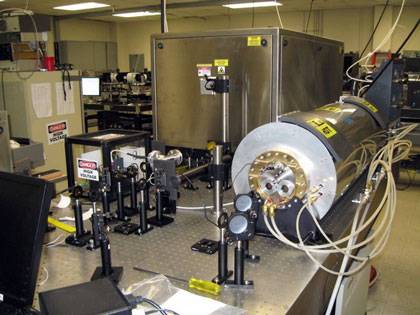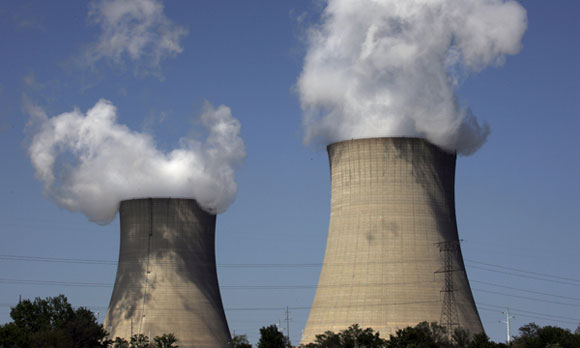
Scientists have developed a way to sniff out tiny amounts of toxic gases -- a whiff of nerve gas, for example, or a hint of a chemical spill -- from up to one kilometer away.
The new technology can discriminate one type of gas from another with greater specificity than most remote sensors -- even in complex mixtures of similar chemicals -- and under normal atmospheric pressure, something that wasn’t thought possible before.
The researchers say the technique could be used to test for radioactive byproducts from nuclear accidents or arms control treaty violations, for example, or for remote monitoring of smokestacks or factories for signs of air pollution or chemical weapons.
“You could imagine setting this up around the perimeter of an area where soldiers are living, as a kind of trip wire for nerve gas,” said lead author Henry Everitt, an Army scientist and adjunct professor of physics at Duke University.
The technique uses a form of invisible light called terahertz radiation, or T-rays.
Already used to detect tumors and screen airport passengers, T-rays fall between microwaves and infrared radiation on the electromagnetic spectrum.
Zapping a gas molecule with a terahertz beam of just the right energy makes the molecule switch between alternate rotational states, producing a characteristic absorption spectrum “fingerprint,” like the lines of a bar code.
Terahertz sensors have been used for decades to identify trace gases in the dry, low-pressure conditions of interstellar space or in controlled conditions in the lab, where they are capable of unambiguous identification and ultra-sensitive, part-per-trillion detection.
But until now, efforts to use the same technique to detect trace gases under normal atmospheric conditions have failed because the pressure and water vapor in the air smears and weakens the spectral fingerprint.
In a study published in the journal Physical Review Applied, Everitt, Ohio State University physicist Frank De Lucia and colleagues have developed a way around this problem.
Their approach works by blasting a cloud of gas with two beams at once. One is a steady terahertz beam, tuned to the specific rotational transition energy of the gas molecule they’re looking for.
The second beam comes from a laser, operating in the infrared, which emits light in high-speed pulses.
At the U.S. Army Aviation and Missile Research, Development, and Engineering Center near Huntsville, Alabama, the researchers have installed a one-of-a-kind infrared laser.
Manufactured by a company called STI Optronics, it’s capable of firing dozens of pulses of infrared light a second, each of which is less than a billionth-of-a-second long.
“It’s kind of like whacking a molecule with an infrared sledgehammer,” Everitt said.
Normal atmospheric pressure still blurs the chemical “bar code” produced by the blast of the Terahertz beam, but the ultra-short pulses of light from the more powerful infrared laser knock the molecule out of equilibrium, causing the smeared absorption lines to flicker.
“We just have to tune each beam to the wavelengths that match the type of molecule we’re looking for, and if we see a change, we know it has to be that gas and nothing else,” Everitt said.
The researchers directed the two beams onto samples of methyl fluoride, methyl chloride and methyl bromide gases in the lab to determine what combination of laser settings would be required to detect trace amounts of these gases under different weather conditions.
“Terahertz waves will only propagate so far before water vapor in the air absorbs them, which means the approach works a lot better on, say, a cold winter day than a hot summer day,” Everitt said.

The Exelon Byron Nuclear Generating Stations in Illinois. Researchers believe one use for the laser will be to detect toxic leaks in small amounts, making it useful in verification of arms control and nuclear weapon agreements. Photo by Jeff Haynes/AFP/Getty Images
The researchers say they are able to detect trace gases from up to one kilometer away. But even under ideal weather conditions, the technology isn’t ready to be deployed in the field just yet.
For one, converting an eight-foot, one-ton laser into something closer in size to a briefcase will take some time.
Having demonstrated that the technique can work, their next step is to figure out how to tune the beams to detect additional gases.
Initially, they plan to focus on toxic industrial chemicals such as ammonia, carbon disulfide, nitric acid and sulfuric acid.
Eventually, the researchers say their technique could also be useful for law enforcement in detecting toxic gases generated by meth labs, and other situations where detection at the gas’s source isn’t feasible.
“Point sensing at close range is always better than remote sensing if you can do it, but it’s not always possible. These methods let us collect chemical intelligence that tells us what’s going on before we get somewhere,” Everitt said.
The paper, "Design and Signature Analysis of Remote Trace-gas Identification Methodology Based on Infrared-Terahertz Double-Resonance Spectroscopy," appears online in the journal Physical Review Applied. Other co-authors include Elizabeth Tanner, Dane Phillips and Christopher Persons of IERUS Technologies in Alabama.
The research was supported by grants from the Defense Threat Reduction Agency (DTRA) and the Defense Advanced Research Projects Agency (DARPA). Additional support was provided by the U.S. Army.